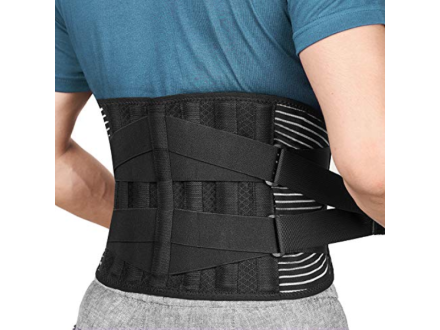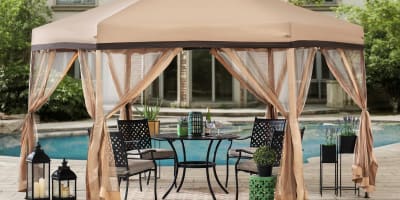We may earn commission from links on this page, but we only recommend products we believe in. Pricing and availability are subject to change.
The best back braces of 2024, according to experts
If back pain is keeping you from doing everyday activities, an over-the-counter back brace can provide relief. Dr. Jeremy Denning, a neurosurgeon and spine specialist, tells AOL,“I often recommend the use of over-the-counter braces for seniors with breaks, sprains or joint pain. Braces can provide support, stability and pain relief, allowing seniors to continue their daily activities while minimizing the risk of further injury.” The best back brace for your needs will vary by condition and pain points, but for the most part, the majority of back braces work by reducing pressure on the spine, when used correctly, which should ultimately improve your ability to tackle daily activities.
Modvel back brace
Best back brace overall
Brace Align VertebrAlign LSO Medical Back Brace
Best back brace for medical grade support
DDS 300 Decompression Belt
Best back brace for sciatica relief
Cueheat Heating and Massaging Back Brace
Best for lower back pain with heat and massage therapy
Sparthos back brace for lower back pain
Best back brace for herniated discs
Freetoo Back Brace
Best back brace for lumbar support
AllyFlex Sports® Back Brace for Lifting and Work
Best back brace for exercise and lifting
Mueller Lumbar 4-in-1 Back Brace with Hot/Cold Pack
Best back brace for hot or cold therapy
Fit Geno Back Brace Posture Corrector
Best back brace for correcting posture
While we do want to stress the importance of consulting with a physician if you are experiencing pain or discomfort, especially if it's severe or prolonged pain, in the meantime, a brace can certainly provide relief and get you back on your feet. To help you find the best back brace for your needs, we’ve taken the guesswork out of finding a brace that can correct posture, offer lumbar support and make those daily activities less painful. To do so, we spoke with leading orthopedic doctors, surgeons and physical therapist to better understand the different styles and uses for back braces. We then took their feedback and looked at dozens of back braces to assess their orthopedic value, tested quite a few ourselves, and read reviews from customers. Our final top picks are all unisex braces for both men and women, can help relieve low back pain, improve posture and support your active lifestyle.
Read more:
The best wrist braces for carpal tunnel syndrome
Best back brace overall
Sizes: Small, medium, large; plus sizes available but cost extra | Best for: Herniated disc, sciatica, scoliosis, lower back pain, arthritis | Level of support: Medium compression, reinforced lumbar support | Material: Felt, Velcro, elastic | Extra features: Extra lumbar pad
The MODVEL back brace offers an affordable, easy-to-use solution to various back problems, including herniated discs, arthritis, scoliosis, and lower back pain. It’s lightweight and made with breathable fabric so that it can be comfortably worn under clothing during physical activity. With double-sided stabilizers and an adjustable lumbar pad, it provides support and extra compression while still allowing movement. Bonus: It’s machine washable and FSA-eligible!
There are six sizes ranging from small to plus size, but it’s worth noting that the price varies depending on size. While small, medium, and large are all priced at less than $35, the plus-size brace is more than twice as much.
- Extra lumbar pad for added support
- Machine washable
- FHA/HSA eligible
- Plus-size option is significantly pricier
Other top back braces we recommend for 2024
Sizes: One size fits most | Best for: Fracture, herniated disc, arthritis, post-surgery, sciatica, degenerative disc disease, cervical spondylosis, and sprains | Level of support: Semi-rigid
A $90 price tag might seem pretty hefty, but for a medical-grade back brace, it’s about as affordable as it gets. What really makes the Brace Align LSO back brace stand out is the removable panel and easy-pull tabs. With most back braces, adjustments are done using the straps. The Brace Align LSO brace has a unique pulley system that allows for easy adjustments for those with arthritis or upper body weakness.
It’s a semi-rigid brace that offers a high level of stability for those with various conditions involving spinal discs, fractures, or sciatica. However, it also features a removable back panel, so you can increase your mobility as you recover.
While it only comes in one size, there is an extension belt available. The extension belt is sold separately and can extend the brace enough to fit a 66-inch waist.
- Removable back panel for more movement
- Easy pulley-system tabs for adjustments
- Designed to conform to the natural curve of the spine for added comfort
- Only offers one size
Sizes: Small, medium, large, XL-6XL | Best for: Sciatica, herniated disc, pinched nerve, degenerative disc disease, spinal stenosis, spondylolysis, chronic back pain | Level of support: Maximum support and compression | Material: Aluminum, polypropylene silicone, velvet, plastic, polyvinyl chloride | Extra features: Spring stays, aluminum stays, adjustable dual elastic stays, 360-degree support
I know, I know, spending over $200 on a back brace seems wild, but hear me out! Disc Descease Solution’s decompression brace is top-notch and one of a kind thanks to being “The Original Spinal Decompression Belt,” backed by 4 US Patents. What really sets it apart is the hand pump with an easy-to-read PSI gauge for customized treatment. Dave Candy, a board-certified specialist in orthopedic physical therapy, tells us, "I commonly recommend [the] back decompression brace by Disc Disease Solutions. These types of back braces lift and unload the spine, not just compress it like regular back braces."
The back support belt has a soft cotton lining and is designed to conform to the natural curvature of the spine for maximum comfort and excellent support. And to top it off, it’s easy to wear under clothing and it’s machine washable. One relieved user with two herniated discs - one is bulging - and a fractured vertebrae said, "If I could, I’d give this belt a million-star rating." Another user mentioned it was, "The only belt that gave me pain relief for my pregnancy-related back pain."
- Available in 10 sizes ranging from small to 6XL
- Machine washable
- Extension pieces available
- Designed to conform to the natural curve of the spine for added comfort
- Expensive
Sizes: One size fits most | Best for: Lower back pain, sciatica, dysmenorrhea | Level of support: Customizable stability | Material: Fabric, carbon fiber |Extra features: Rechargeable, three heating temperatures, three vibration modes, two-way power supply 7.4 volt, USB charger, Velcro battery pocket, adjustable elastic strap
The back support brace from Cueheat isn’t your typical back brace: it's equipped with heat and massage therapy. “Heat has a pretty good track record of benefit,” Loafman tells us, “Some recent studies even suggest that heat should replace ice in most situations, including recent injury.” Of course, he warns that more research is needed, (and discussions with your own healthcare provider are always recommended,) but there’s no denying how helpful heat therapy can be in reducing muscle pain. The brace has two removable columns for customizable stability and offers cordless, battery-operated heat-based massage therapy for targeted pain relief.
Back pain aside, this brace can also be used for pain associated with menstrual cramps. On top of that, it has a vibrating massage component. You can plug it in or use the cordless battery pack, which is great if you don’t want to be restricted to sitting next to the nearest outlet. The 1,400 five-star reviews raving about the back brace's ability to relieve many ailments has us all wanting one. The only downfall is that it’s not washable due to the heating and massage mechanisms, so spot clean with a damp cloth.
- Offers heat and massage therapy
- Battery-operated for cordless use
- Removable side supports
- Spot clean only
Sizes: Small, large, XL | Works for: Herniated disc, sciatica, scoliosis, degenerative disc disease, spinal stenosis, lumbar support | Level of support: Medium compression with extra lumbar support | Material: Nylon | Extra features: Adjustable lumbar pad, flexible elastic mesh, firm support stays, secure Velcro, breathable fabric
As we age, one thing that affects us all is the impact of wear and tear on the spine. The cushioning between the vertebrae in our spine gets more fragile and becomes much more susceptible to herniated or slipped discs, which can be extremely painful and, at times, debilitating. The Sparthos lower back support brace is one that is great for minor back discomfort or herniated disc(s). It is also effective as a preventative measure to ward off back pain when doing a task that puts repeated pressure on the back and spine, such as heavy lifting or even gardening.
Designed with firm vertical stays and an adjustable lumbar pad to provide extra support, the Sparthos brace provides stability and pain relief almost instantly, thanks to lifting the load on your disc. The dual compression straps are easily adjustable for more or less flexibility, depending on your needs. It comes in three sizes – small, large, and extra-large. While sizing is limited and somewhat confusing, you can easily find the appropriate brace for your size by following the manufacturer's instructions for taking your waist measurement.
- Removable lumbar pad
- Double layer of adjustable straps
- Breathable material
- Limited sizing
Sizes: Small, medium, large, XL, XXL | Best for: Lumbar support, lower back pain, herniated disc, sciatica, scoliosis, degenerative disc disease | Level of support: Maximum compression | Material: Aluminum, polypropylene, silicone, velvet, plastic, polyvinyl chloride | Extra features: Adjustable dual elastic straps, two silicone anti-skid bands, four Memory-aluminum stays, four4-way stretch elastic material
The Freetoo back brace has a whopping six aluminum stays to provide serious lumbar support. The elastic straps can easily be pulled tight for added compression and lumbar support when needed most, and thanks to the double seams, you'll never need to worry about the brace coming apart when pulled tight. The back brace is also equipped with two silicone anti-skid bands on either side to keep the brace in place - this is not a common feature and we appreciate it so much. Another cool feature (and we mean "cool") is the lightweight, four-way stretch material designed with breathable mesh channels to help keep your back from becoming a sweaty mess. This brace is designed extremely well, built to last, and accommodates a wide range of sizes. And don't just take our word for it; there are nearly 17,000 five-star reviewers singing its praises as well.
- Six aluminum stays for strong support
- Air-mesh, four-way stretch material
- Anti-skid silicone bands
- Hand wash only
Sizes: XS/small, medium, large, XL/XXL | Works best for: Exercise, heavy lifting, bending, lumbar support | Level of support: Medium compression with maximum lumbar support | Material: Neoprene | Extra features: Detachable Y-shaped suspenders, two ergonomic lumbar pads, high compression, CoolMax lining
Even if you don’t have any back problems, if you regularly engage in heavy lifting, there’s a heightened risk of strain or injury. Wearing a brace while performing strenuous activities can help prevent potential damage by stabilizing the spine and promoting proper form. Imagine spending the weekend moving or spreading mounds of mulch without any pain during or after. This brace makes that your new normal.
The AllyFlex Sports back brace is designed to provide the back support necessary during bending and lifting. It features detachable, easily adjustable Y-shape suspenders and lumbar pads on either side for extra lumbar support. We also love the multi-layer design that keeps you cool, supported and stable. For those in warm climates or prone to sweating, you’ll love the inner layer that features moisture-wicking CoolMax fabric that helps to keep you cool and dry. The second layer of perforated neoprene provides extra compression for added support. Finally, the outer nylon layer ensures extra durability.
- Breathable, moisture-wicking fabric
- Provides compression and support
- Velcro may wear out quickly
Sizes: One size fits most | Best for: Lower back pain, lumbar support | Level of support: Semi-rigid medium compression | Material: Plastic | Level of support: Semi-rigid medium compression | Material: Plastic | Extra features: Dual- sided removable lumbar pad, removable hot/cold pack, four4 flexible stays
After an injury, it’s generally recommended that you alternate cold and heat therapy. Cold can reduce swelling and inflammation, which is why it’s best in the first 24 to 72 hours. Heat, on the other hand, helps reduce muscle pain and stiffness. So, why not find a brace that allows you to do both?
The Mueller 4-in-1 brace comes with a reusable gel pack that can be used hot or cold, depending on your injury. It also comes with a reversible lumbar pad – one side is padded while the other is rigid, so you can customize it to fit your needs. It only comes in one size, so measure your waist before buying to ensure it will fit.
- Removable lumbar pad
- Reusable hot and cold gel pack
- Lightweight
- Only one size is available
Sizes: Small, medium, large | Best for: Posture, scoliosis, lumbar support | Level of support: Medium compression and lumbar support | Material: Neoprene | Extra features: Breathable material, double straps, easy to clean, 2-in-1 back support and corrector
Did you know prolonged sitting with a slumped posture could increase the risk of having lower back pain? It’s true. Thankfully, posture-correcting back braces are available to both get your posture on track and your back out of whack. While many posture-correcting back braces only support the middle and upper back, Fit Geno’s posture-corrector brace delivers full coverage targeted support. It gently pulls your shoulders up and back to help promote good posture and deliver lumbar support. Made from moisture-wicking and breathable material, the brace’s lightweight design makes it easy to wear under clothing. And best of all, it’s machine washable!
- Full back and waist support
- Breathable material
- Comfortable for daily use
- Limited sizing
Factors to consider when choosing the best back brace for your needs
Level of support: Understand whether you need a rigid, semi-rigid brace, medium or maximum compression, as well reinforced lumbar support; this may include a discussion with your healthcare provider. Rigid braces offer more immobilization and are used after surgery, trauma, or severe injuries. Semi-rigid braces provide both support and flexibility and can be used for moderate pain or strains. Compression braces allow more movement and are used for mild pain or to provide extra support during exercise. Braces with reinforced lumbar support are great for those with disc pain or need support during heavy lifting.
Size and fit: For a brace to work, it must fit correctly. Take your measurements before choosing your brace to ensure you get the right size. Also, look for a brace with adjustable straps so that you get the best fit.
Comfort: A big part of the comfort level will depend on the type of brace you choose; rigid braces are less likely to feel comfortable.
Material: The material is also something to look for. Choose a brace with breathable, lightweight fabric that can easily be worn under clothing without irritating your skin. This will also help make it more comfortable to wear. Extra bonus points go to a brace that is machine washable.
Durability: Who wants a brace that doesn’t last as long as they need it to? Look for a brace that’s easy to maintain and uses high-quality materials that are meant to stand the test of time.
Extra features: Some braces have extra features that may be beneficial, such as removable supports or padding, heat therapy, ice packs, or a vibrating massage component. Dr. Jennifer Woods, an orthopedic surgeon, tells AOL, "Some braces include cold and/or hot therapy. In general, cold therapy is most beneficial in the first few days after injury, and heat therapy can be helpful when further along in the recovery phase and attempting to regain flexibility in the joint. When in question about what type of brace would be best for you, consult with your healthcare provider."
How we chose
We first consulted with two physical therapists, a primary care doctor and an orthopedic surgeon to better understand the various types of back pain, the best back brace for each condition, and what to look for in a well-constructed back brace. Our team then researched over 20 different types of back braces available to purchase over the counter and evaluated each based on our experts' feedback. These measurements included level of support, comfort, wearability, and ease of use to create a short list of the best braces. We then omitted the braces that came up short on materials used, maintenance required, and sizing options available. As always, we also considered user feedback and reviews.
Back brace FAQs
Who should use a back brace?
Back braces are commonly used for back injuries, postoperative recovery, and spine deformities, such as scoliosis. People with degenerative disc disease or a herniated disc or who are experiencing sciatica may find relief from wearing a back brace. According to physical therapist Don Levine, those suffering from arthritis or chronic back pain would also benefit. “Aging joints, along with loss of muscle strength and mobility, can lead to increased compression causing [more back] pain,” he says. “Braces can help keep some of the stress off joints, reduce pain and help seniors tolerate more activity.”
You can also consider wearing a brace to improve your posture, prevent injury during heavy lifting, or alleviate pain during pregnancy.
How long should you wear a back brace?
There’s no one-size-fits-all answer – how long you wear a brace depends on the condition it’s treating. It’s always advisable to consult a doctor and follow their instructions, but generally speaking, back braces for muscle weakness, strains, or mild injuries are only recommended for two to four days. Postoperative braces, on the other hand, may be worn for upwards of six to eight weeks.
“Extended use of over-the-counter immobilizers could be detrimental,” says Woods. If you feel you need prolonged use of a back brace, it’s best to consult with your physician first. If you’re using a brace to minimize pain or prevent injury during exercise and other activities, though, that timeline won’t really apply. Instead, you’ll want to wear the brace only as needed while performing the activity.
Should I wear my back brace to bed?
Unless you’re advised to by your doctor, back braces should not be worn while sleeping. Certain conditions may require full-time brace treatment, meaning the brace is worn for up to 23 hours a day. In those cases, though, it will be prescribed by a doctor.
For soft braces, nighttime use isn’t required or even recommended. Posture-correcting and lower back braces are designed to be worn while standing, sitting, or engaged in activity, so there’s no use wearing to bed. Plus, it could make sleeping more difficult.
How long should I wear a posture-correcting back brace?
Posture correctors are not meant to be worn all day long. Initially, it’s a good idea to start slow and wear one for 20 to 30 minutes at a time. As long as it’s comfortable, you can gradually increase the time up to one or two hours a day. Along with wearing a brace, try to add in some posture-correcting exercises and stretches.
Some braces may include cold and/or hot therapy. In general, cold therapy is most beneficial in the first few days after injury, and heat therapy can be helpful when further along in the recovery phase and attempting to regain flexibility in the joint.
When in question about what type of brace would be best for you, consult with your healthcare provider.
What kinds of back pain do back braces treat?
Back braces are designed to alleviate back pain caused by a variety of conditions including herniated discs, degenerative disc disease, bulging discs, arthritis, sciatica and various decompression issues. Some of these conditions are the result of injuries, while others are caused by disease, inflammation and poor posture. Back braces offer targeted relief for these conditions by providing stability, which can promote and facilitate healing. As always, it’s best to consult with a doctor about whether a back brace can alleviate your particular type of pain.
When should I see a doctor about my back pain?
You should immediately seek urgent medical care if you experience severe debilitating back or neck pain with or without a fever. In the case of non-urgent, mild back pain, it's best to rest, consider over-the-counter medications to help reduce pain and inflammation, and alternate between cold and heat therapy. But if your pain gets worse or hasn’t improved after a few days of proper self-care, you should see a doctor. Additionally, it’s a good idea to speak to a doctor or healthcare professional before using a back brace. They can help advise you on the best type to wear and for how long.
Meet our experts
Melissa Boyette, MD, orthopedic surgeon
Dave Candy, PT, DPT, OCS, ATC, FAAOMPT
Patrick Dermarkarian, MD, orthopedic spine surgeon
Liza Egbogah, BSc, DC, DOMP
Stephen J. Wallace, MD, orthopedic trauma and deformity specialist
Jennifer Woods, MD, orthopedic surgeon
The reviews quoted above reflect the most recent versions at the time of publication.








